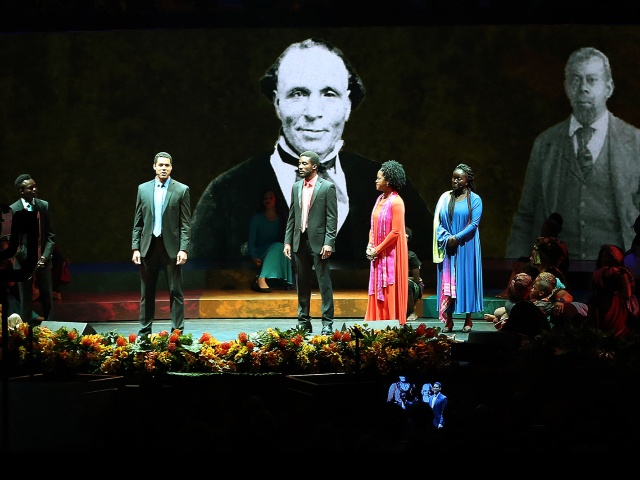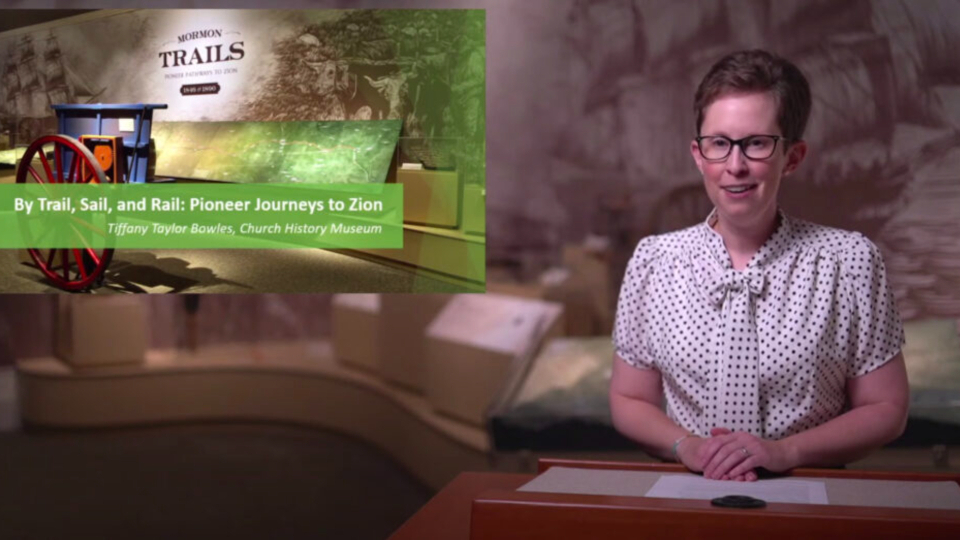
Pioneer-Items
Tiffany Taylor Bowles presented “By Trail, Sail and Rail: Pioneer Journeys to Zion” on Thursday, July 22, 2021, as part of the Church History Museum’s Evenings from the Museum series. Screenshot courtesy of Church News.All rights reserved.This story appears here courtesy of TheChurchNews.com. It is not for use by other media.
By Christine Rappleye, Church News.
After early members of The Church of Jesus Christ of Latter-day Saints were baptized, many of them would emigrate from their homelands to gather with others in the Salt Lake Valley.
“Nineteenth century Latter-day Saints were asked to gather to one general location as a means of protection and so that they could live and work together in a righteous peaceful society,” said Tiffany Bowles, an associate curator of education at the Church History Museum, during a streamed Evening from the Museum presentation titled “By Trail, Sail and Rail: Pioneer Journeys to Zion” on Thursday, July 22. Her presentation was from the museum’s Mormon Trails: Pioneer Pathways to Zion exhibit.
The Saints would use various modes of transportation to get to Zion, including walking or using a wagon pulled by teams of oxen, sailing across the ocean, and, later, traveling by train. By 1890, members of the Church were encouraged to stay in their home countries and build the Church there.
Bowles shared three stories of pioneers who during their journeys came over land, on a boat or on a train, along with an item in the exhibit that is connected to each.
“We can be inspired by Green Flake’s resilience in the face of adversity, by Jean Rio Baker’s perseverance despite numerous setbacks, and by Niels and Margarethe Nielsen’s courage to leave their homeland for a new, a foreign, country,” Bowles said. “Those who have gone before us can motivate each of us to carry on as we embark on our own journeys of faith through this life.”
Trail
Green Flake was one of three enslaved men who were in the vanguard company that Brigham Young led 1,300 miles to the Salt Lake Valley in 1847. In the coming decades, 60,000 to 70,000 people would follow.
“Green drove the first wagon through Emigration Canyon on July 22, 1847,” Bowles said. “And by the time Brigham Young arrived in the Salt Lake Valley on July 24, Green had already begun to plow ground for planting.”
Green Flake built a home and plowed land for his owner, James Flake, who arrived with his family in 1848.
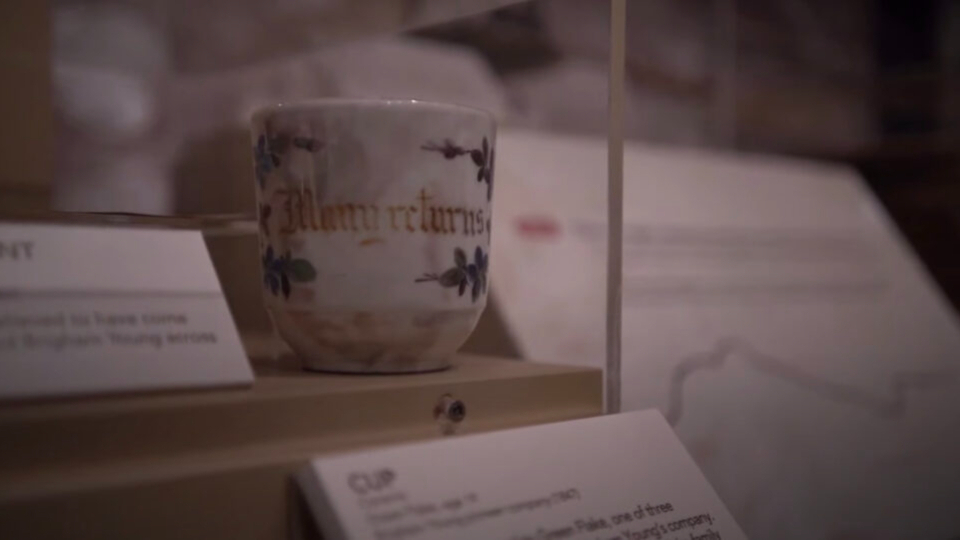
Pioneer-Items
This cup was once owned by Green Flake and is part of the Mormon Trails: Pioneer Pathways to Zion exhibit at the Church History Museum. Screenshot courtesy of Church News.All rights reserved.Green Flake later married and had children. James Flake passed away in 1850, and his widow moved to California in 1854. She requested that Brigham Young sell Green and send her the money, but no sale took place, Bowles said. Green and his family were listed as free inhabitants in the 1860 territorial census.
A small porcelain cup that belonged to Green Flake is in the Mormon Trails exhibit. It’s painted with flowers and the words “Many returns.” Where he got the cup is unknown, but a great-granddaughter said it was in Green’s home for many years, Bowles said.
The cup also survived a house fire. “Although it bears the marks of the fire, it is otherwise unscathed,” she said.
Bowles said that is a metaphor of Flake’s life.
“Green Flake had to endure the added hardship of living as an enslaved person, and even after obtaining his freedom being denied many opportunities, even within the Church, because of the color of his skin,” she said. “Yet he lived a life of faith despite the difficulties he faced.”
Sail
Jean Rio Baker, a 40-year-old widow with seven children, left London for Liverpool, England, on Jan. 4, 1851. In Liverpool, the family boarded the ship George W. Bourne bound for America. It took nearly two months to sail to New Orleans, Louisiana, and Jean’s 4-year-old son, Josiah, died during the voyage.
“Jean was one of approximately 90,000 other Latter-day Saint converts who crossed the ocean in the 19th century,” Bowles said.
The family took a steamship to St. Louis, where they stayed while they prepared for the journey west, including buying four wagons and eight yoke of oxen. Like other Latter-day Saint families, they loaded their belongings onto a steamship to Alexandria, Missouri. From there, they made their way to Kanesville, Iowa, where they joined the John Brown Company, which consisted of 50 wagons and 235 people. The company received assistance from the Perpetual Emigration Fund, which helped more than 30,000 people travel to Utah, she said.
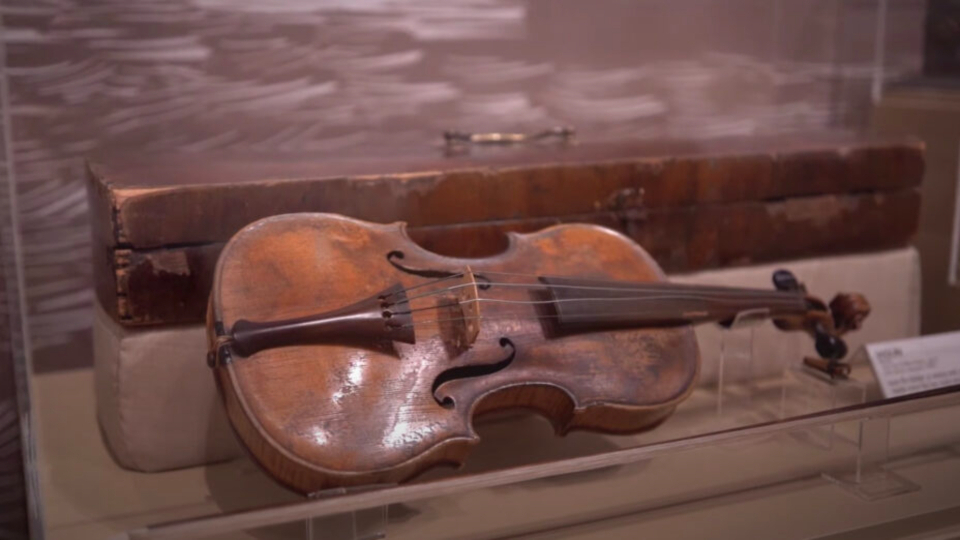
Pioneer-Items
When Jean Rio Baker emigrated from England in 1851 as a widow with seven children, this violin was one musical instrument her family brought. It’s part of the Mormon Trails: Pioneer Pathways to Zion exhibit at the Church History Museum. Screenshot courtesy of Church News.All rights reserved.Their trip west had the hazards of heat, broken-down wagons, swollen creeks, accidents, injuries and the deaths of a couple of company members. One of her oxen fell into a stream and drowned. Baker became a grandmother when her daughter Eliza gave birth to a son.
The family arrived in Salt Lake City on September 29, 1851.
“Jean wrote in her diary, ‘I can hardly analyze my feelings, but I think my prevailing ones were joy and gratitude for the protecting care had over my and mine during our long and perilous journey,’” she said.
They traveled for nearly nine months, covering 7,700 miles. They went 5,400 nautical miles by ship, 1,000 miles by steamboat and 1,300 miles by covered wagon.
One of Jean’s four wagons reportedly contained mostly musical instruments, including a violin that’s on display in the Mormon Trails exhibit.
“Jean’s violin, which survived the entire trip, reminds us that Latter-day Saint converts from different countries brought elements of their old life and culture with them, contributing to a diverse and eclectic society in Utah,” Bowles said.
Rail
“When the transcontinental railroad was completed in 1869, travel to Utah became much easier, less expensive and faster for Latter-day Saint converts,” Bowles said. It opened up new possibilities for those traveling to Utah.
One of those was Niels Peter Nielsen, who was baptized in 1869 in Denmark. He was driven from his town and had been turned away by family and friends, she said. He was called to serve a mission on Bornholm Island in the Baltic Sea.
“During his missionary service he was attacked and nearly killed by a mob of 75 men,” she said.
It was during this time that he met Margarethe Petersen, who also had to leave home when she joined the Church. After nearly six years of missionary service, Nielsen was given a ticket to sail to the United States and begin his journey to Utah.
“On June 21, 1876, the day before his departure, he and Margarethe were married, so they could make the journey together,” Bowles said.
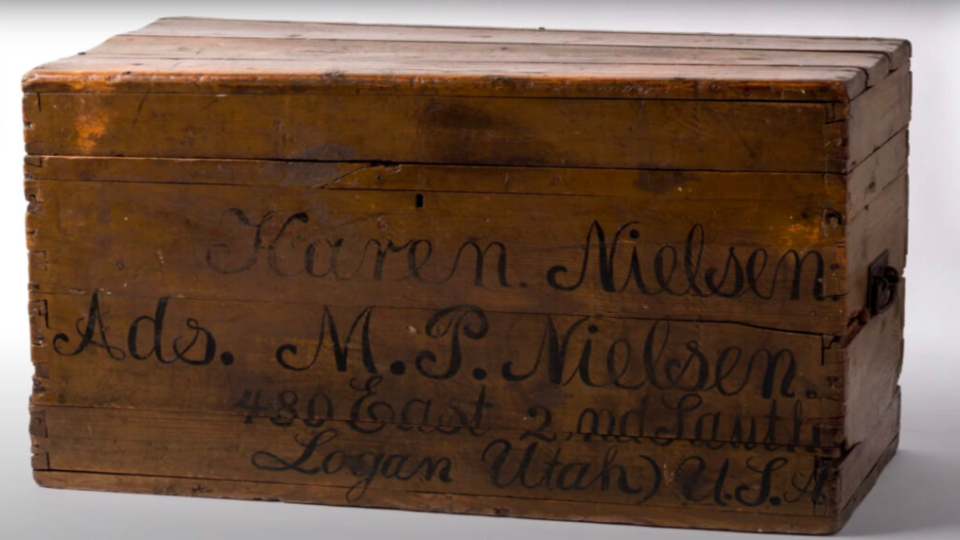
Pioneer-Items
This trunk, once owned by Margarethe Nielsen who emigrated from Denmark, is part of the Mormon Trails: Pioneer Pathways to Zion exhibit at the Church History Museum. Screenshot courtesy of Church News.All rights reserved.They took a steamship from Copenhagen, Denmark, to England, and a train across the nation to Liverpool. They then boarded the ship Idaho bound for New York City on June 28, 1876. The voyage across the Atlantic took 14 days. The Nielsens, along with other converts, boarded the train in Jersey City and eventually arrived in Ogden, Utah, on July 18, 1876.
“Thanks to transportation innovations, Niels and Margarethe’s entire journey from Copenhagen to Salt Lake had taken less than a month, an unimaginable feat in prior decades,” Bowles said.
They moved to Logan and rented a home. In 1877, they bought a lot and built a home at 480 E. 2nd South in Logan. It’s to this address that a trunk was sent to M.P. Nielsen, possibly for Margarethe Petersen Nielsen.
“While Margarethe’s relation to Karen, who sent the trunk, is unknown, it is possible that the trunk could have been sent to Utah from Denmark,” Bowles said. Niels had returned to Denmark on a mission and found that his mother and sister had joined the Church.
“Her trunk reminds us of their willingness to leave behind their native land and everything that was familiar to them, to gather with others of their faith,” Bowles said.
The presentation is available on the Church History Museum’s Facebook page and the Latter-day Saint History YouTube channel.
The Church History Museum is currently closed and is scheduled to reopen on Aug. 2.
Copyright 2021 Deseret News Publishing Company
